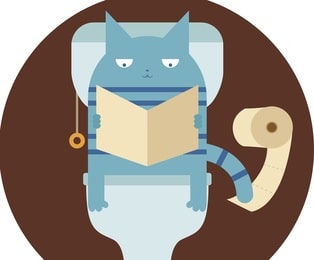
You think your cat is constipated. Do you know the signs? (Check them out in the article below.) Then, you can try:
- Offering kitty cat grass since it is a natural laxative.
- Adding indigestibles (fiber, fur) to your pet’s diet.
- Increasing your cat’s exercise via play.
- Massaging your feline’s belly.
- Moving the litter box to a more private and quiet place.
- Taking your cat to the vet.
Before we dive into the issue of cat grass, let’s talk about feline constipation.
Do any of the following apply to your cat?
- He or she is straining to poop.
- Your pet has a lot less poop than usual.
- The feces (poop) is hard and dry.
- Your cat is pooping in places other than the litter box.
- The stool (poop) is liquid, perhaps with traces of mucus or blood.
- Kitty is vomiting or is off his/her food.
- Your pet seems depressed.
If any of these above symptoms of constipation fit your cat, it is best to make an appointment with your vet.
NOTE: If your male cat is straining while in the litterbox, get to your vet ASAP. This could be a sign of a blocked urinary tract. This is a medical emergency.
Here’s what the vet might do…
1. The exam and tests
Your vet may order blood and urine tests. These tests are done to rule out a urinary tract infection.
Palpation of the abdomen (feeling around the abdomen) is important. Your vet is checking to see if the colon is clogged with fecal matter (poop).
If needed, your vet will order a radiograph of the colon. An x-ray is a type of radiograph.
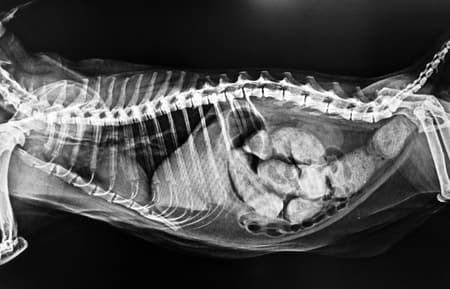
Ultrasound might also be used to check whether the issue is a tumor.
2. Treatment options
If your pet is dehydrated, your vet may begin intravenous fluid therapy to put back essential fluids into the body.
Mild constipation is often treated with a change of diet. Your vet will recommend foods and fiber which increase the movement of fecal matter (poop) through the digestive system.
Medications may also be prescribed to make the fecal matter more liquid.
Both dietary changes and giving medication are things you will do at home once you have the proper ingredients/equipment.
As a next step, if the previous treatments did not work, your vet will give your pet a warm water enema.
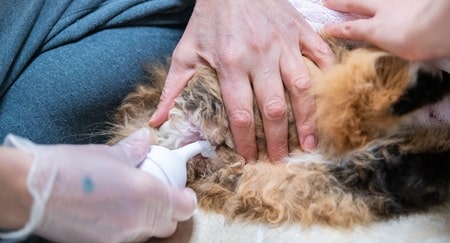
Warm water will be inserted into your cat’s butt and then allowed to come out.
Your vet will repeat as needed to unblock your cat’s colon.
***Under no circumstances should you give your cat an enema unless your vet has thoroughly trained you in this delicate procedure.***
If none of the above work, or your cat’s constipation is extreme to begin with, your vet may need to anesthetize your cat and perform a surgical procedure on him or her.
The vet will use instruments to go into the colon and clean our the hardened stools.
Now that we know kitty is not in any immediate danger, let’s see how we can prevent your pet from being constipated in the future.
1. Cat grass can prevent constipation as it is a natural laxative.
(At least this is what the experts think.)
Why does eating cat grass help?
Some experts say that the cat grass probably adds fiber and bulk to the cat’s diet, helping stools to pass more easily.
Others point to the fact that cats cannot digest cat grass. As a result, they vomit it up…along with other things they can’t use such as fur balls from grooming and bones/feathers from any prey eaten.
So even though cleaning up your cat’s throwup is a nasty job, please don’t punish them. They are only trying to stay healthy.
Do different types of cat grass have different effects?
It seems that broad-leaf cat grass is a better laxative while thinner-leaved cat grass is a better emetic (causes vomiting).
Either way, eating grass helps cats clean out their systems.
Must cats eat cat grass or any grass for that matter?
Vets say that healthy cats can pass out toxic matter via poop or vomit without the help of cat grass, so it is not absolutely necessary.
Can a cat eat too much cat grass?
Strange as it may seem, cats tend to love eating grass.
In small quantities, cat grass is fine for cats.
If your cat is eating large quantities, however, you should have him/her checked out by your vet…just in case.
2. More indigestibles in your cat’s diet = less constipation
As we said above, cat grass is indigestible. So, your cat must vomit it up or pass it through their poop.
In general, there is a direct relationship between indigestible matter and stool volume/frequency: the more indigestibles in your pet’s diet, the more they will poop and the more often they will poop.
A rather sad example is cats who are fed poor quality, commercial dry food. These cats will produce stools which are larger, smellier, and more frequent than normal.
You don’t want to overdo things though, so pay attention to the size and quantity of kitty’s poop.
Adding filler to your cat’s daily diet
Most commercial cat foods include filler in their recipes. So, serving some to your cat will help increase fecal output (more poop).
Another very popular idea is canned pumpkin. Start by mixing in 1 tablespoon to wet cat food to see if your cat likes the taste.
If your pet will eat food with added pumpkin, add 1 tablespoon to your pet’s food several times each day.
You can also buy raw pumpkin, steam it, then puree or mash it.
Yams or butternut squash prepared in this way are other good options.
3. Encourage your cat to ingest fur

If your cat eats prey with fur, he or she is getting the perfect stool bulker.
Your cat’s own fur is a very good second option.
As your kitty naturally grooms itself, it will take in a lot of fur. Great!
So, don’t brush or wash your cat too often.
4. Water, water, and more water
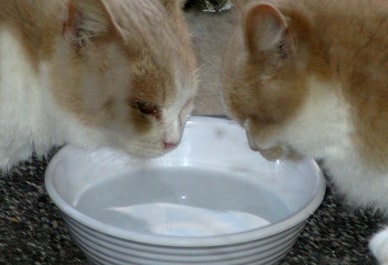
Flickr, author Frankieleon, Caring is Sharing
Is your cat drinking enough?
Even if you have a water bowl, your pet may not be taking in the water he or she needs.
Dehydration can cause feces to become hard and dry.
Increasing your cat’s intake of water is a key way to reduce constipation.
Make drinking interesting.
My indoor cats loved drinking out of the toilet bowls.
My outdoor cats often lap at the puddles I create when watering my garden.
Before I was vegan, I bought tuna canned in water. My cats were crazy for this treat…especially if there were bits of tuna in the water.
Offer your kitty a variety of water sources to ‘spice up’ his or her drinking options.
Wet cat food contains water.
Is your pet on dry food only?
Including wet cat food once a day will naturally increase your pet’s water intake.
5. Try raw liver to keep your cat unconstipated
Like the thinner-leaved cat grass, raw liver often has a mild laxative effect, preventing feline constipation.
6. Add some fat to kitty’s diet
Like in humans, fat is beneficial for the feline digestive system.
Fat helps poop move faster through the digestive tract. Fat also encourages people and cats to poop more often.
Which fat to use?
Opinion is divided.
One cat expert recommended experimenting with olive, canola, and sunflower oils. She suggested pouring a small amount (about 1 tablespoon) into a dish and seeing if your cat will lap it up.
The oil in canned (tinned) tuna is another suggestion I found.
However, a vet disagreed. The vet said that olive oil could cause your cat’s digestive system to get upset, so it is not recommended.
The vet was in favor of commercial, laxative oral gels such as Lax’aire and Laxatone.
I recommend asking your vet before giving fat, oil or commercial laxatives to your cat.
7. Fiber can help cat constipation
Just like the cat grass, other forms of fiber can bulk up your cat’s stools.
Is this a good idea? Experts don’t always agree.
I found professionals who advised using wheat bran or commercial, ‘same as for humans’ fiber products such as Metamucil.
Others said adding fiber was not a useful idea.
Here, too, I recommend consulting your vet.
8. Overweight kitties tend to have more constipation
Has your cat put on more weight than is good for him or her?
Partner with your vet to help your cat reduce excess pounds and lower his or her chances of becoming constipated.
9. Inactivity can constipate your pet
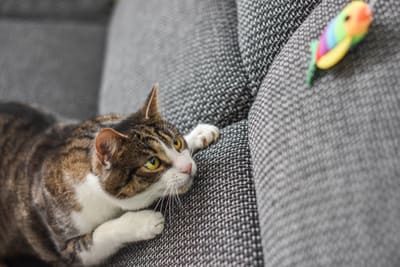
It may be that your cat is not active enough.
Encourage your cat to play more
Increase the number of cat toys you offer your pet, but don’t offer them all at once.
Like children, cats can get bored of their toys.
So, put out a few at a time, and vary them often.
If you find your cat wants to stop playing, it can be because they are used to hunting in quick short bursts.
With some cats, it’s best to do lots of shorter play sessions, instead of one long one.
Also, how much time are YOU spending playing with your cat?
Even though they are much more self-sufficient than dogs, cats still need attention.
Playing with them is a good way to give them attention…and keep them unconstipated at the same time.
Give indoor cats climbing and jumping options
Cat trees are perfect for this. They come in a wide variety of sizes and configurations.
You can put a cat treat at the top to coax your pet into getting some exercise.
10. Change or discontinue the medication
Just as in people, some medications can constipate your cat
If your cat is taking medication, get in touch with your vet and tell him or her about the constipation.
Your vet will advise you of your options.
11. Massage your cat’s belly
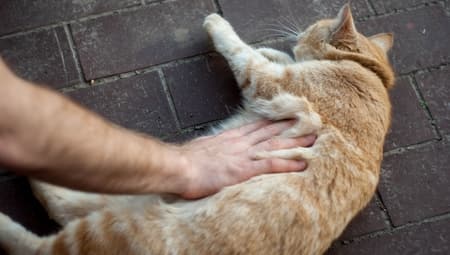
Massaging the abdomen (belly) has several beneficial effects:
- It speeds up the entire digestion and elimination process.
- Bowel movements become more frequent.
- There is less pain and discomfort even with chronic constipation (constipation that hangs around for a very long time).
Cats love massage.
Kitty lovers know how much their pets adore being massaged.
And if this action can help them stay unconstipated, all the better.
Remember to use a gentle pressure, and stop whenever your cat has had enough.
Why does massage help with feline constipation?
The data appears to show that belly massage stimulates the nerves in the gut.
This stimulation helps the digestive tracts do its job more efficiently and effectively.
12. Maybe pooping hurts your cat
Perhaps your cat was constipated in the past, and this constipation caused your kitty pain.
You cat will remember this pain. Your pet will not want to poop in order to avoid the pain he/she remembers.
Not pooping when needed causes constipation.
Discuss this situation with your vet.
13. Location, location, location
Where the litter box is placed may affect how often your cat poops.
Does your cat have privacy?
Cats prefer to poop in private.
How much privacy does your cat have to ‘do his or her business’?
How to create a private place for your cat’s litter box
- In a room that is not always used (like a storeroom)
- On the other side of a screen
- Behind a large and high piece of furniture
What about noise or heat?
Many noises scare cats.
Heat can cause the litter box to smell rather stinky as the urine and poop warm up.
Tips for litter box placement
- Not in the laundry room – noise from the appliances, heat from the dryer
- A box on each floor of the house
- Not near the cat’s food and water bowls
- Wedge doors open from both sides so your cat does not get trapped inside the room
14. Keep the litter box clean and fresh
We know from how often they groom themselves how much cats like cleanliness.
If their litter box is too dirty or smelly, a cat will not use it…even if that means becoming constipated.
Writer: Lisa Aharon
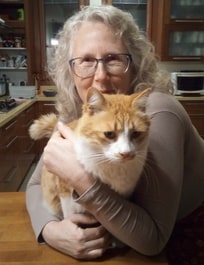
Sources
http://www.vetstreet.com/care/constipation-in-cats
http://www.vetstreet.com/care/constipation-in-cats
http://www.vetstreet.com/our-pet-experts/why-does-my-cat-eat-grass-or-houseplants
https://feline-nutrition.org/health/constipation-real-help-for-your-cat
https://petlifetoday.com/vet/what-to-give-a-constipated-cat/
https://www.hillspet.com/cat-care/behavior-appearance/why-do-cats-eat-grass
https://www.humanesociety.org/resources/preventing-litter-box-problems
https://www.metamucil.com/en-us
https://www.petmd.com/cat/care/8-ways-help-your-constipated-cat
https://www.veterinarypracticenews.com/neuromodulation-for-constipation/
https://www.veterinarypracticenews.com/neuromodulation-for-constipation/
https://www.vetoquinol.ca/eng/products/laxatone-lubricant-hair
https://www.vetrxdirect.com/product/view/laxaire-laxative-for-cats-and-dogs-otc